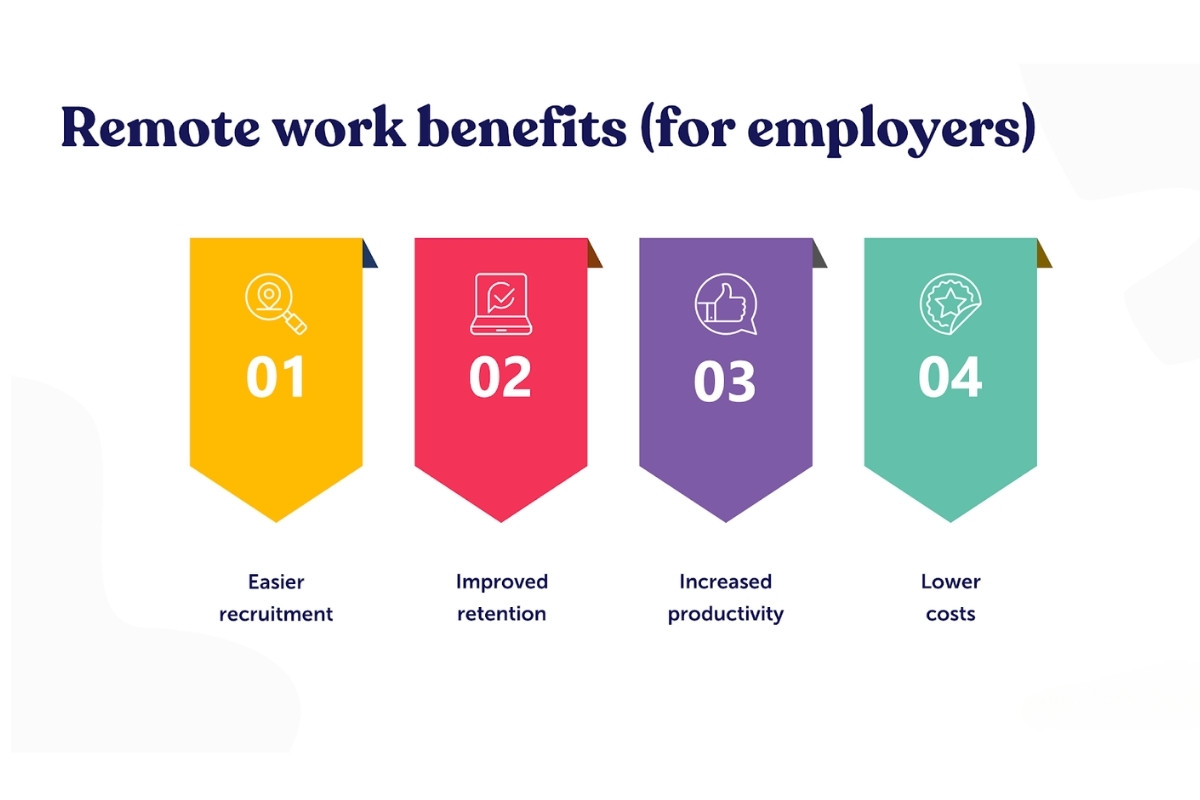The debate between remote work and office work has become a hot topic in recent years. With technological advancements and shifting workplace dynamics, businesses are re-evaluating their traditional office setups and considering the benefits of remote work. But which option is better for your business? In this article, we’ll compare the advantages and challenges of both remote and office work to help you determine the best fit for your company.

Table of Contents
Toggle1. Understanding Remote Work and Office Work
1.1. What is Remote Work?
Remote work, also known as telecommuting, allows employees to perform their jobs from locations outside of a traditional office. This could be from home, coworking spaces, or even different countries. With the rise of digital collaboration tools like Zoom, Slack, and cloud-based software, remote work has become more feasible than ever.
1.2. What is Office Work?
Office work refers to the traditional model where employees commute to a physical office to perform their tasks. This setup provides a structured environment and fosters in-person collaboration, which has long been the norm for businesses across industries.
Read more: Cloud Computing vs. Edge Computing: What’s the Difference?
2. Advantages of Remote Work
2.1. Increased Productivity and Flexibility
- Employees can work during their most productive hours, leading to improved efficiency.
- Flexible schedules allow for better work-life balance, reducing stress and burnout.
- Fewer office distractions can enhance focus and task completion.

2.2. Cost Savings for Businesses
- Companies save on office rent, utilities, and maintenance.
- Reduced expenses for commuting and office supplies.
- Businesses can hire talent from anywhere, often at lower costs.
2.3. Access to a Global Talent Pool
- Remote work allows businesses to recruit from a diverse, worldwide talent pool.
- Companies can find highly skilled professionals without geographical limitations.
2.4. Better Employee Satisfaction and Retention
- Employees appreciate the flexibility and freedom remote work offers.
- Reduced commute times lead to lower stress levels and higher job satisfaction.
- Happier employees are more likely to stay with the company long-term.
3. Challenges of Remote Work
3.1. Communication and Collaboration Issues
- Lack of face-to-face interactions can lead to misunderstandings.
- Team cohesion may weaken without regular in-person meetings.
- Time zone differences can complicate project coordination.
3.2. Distractions and Self-Discipline
- Home environments can be distracting, especially with family responsibilities.
- Some employees struggle with time management without direct supervision.
3.3. Security and Data Protection Risks
- Remote work increases the risk of cyber threats and data breaches.
- Businesses must invest in secure communication and data encryption tools.

4. Advantages of Office Work
4.1. Stronger Team Collaboration and Culture
- Face-to-face interactions build better relationships among colleagues.
- Employees can easily brainstorm, share ideas, and solve problems together.
- A physical office fosters a sense of belonging and teamwork.
4.2. Better Supervision and Productivity Monitoring
- Managers can directly oversee work progress and address issues quickly.
- Employees may feel more accountable in an office setting.
4.3. Clearer Work-Life Boundaries
- The physical separation between work and home helps maintain a structured routine.
- Employees can disconnect from work more effectively after office hours.
4.4. Improved Security and IT Infrastructure
- Offices provide better control over data security and IT infrastructure.
- Sensitive company information is less likely to be exposed to cyber threats.
5. Challenges of Office Work
5.1. High Operational Costs
- Office rent, utilities, and maintenance can be expensive.
- Businesses must provide equipment, supplies, and other resources.
5.2. Commuting Stress and Time Waste
- Employees spend time and money commuting to work.
- Traffic and long travel times can lead to exhaustion and decreased productivity.
5.3. Less Work-Life Balance
- Fixed office hours may not accommodate employees’ personal needs.
- Employees may feel burned out due to rigid work schedules.
6. Hybrid Work: A Balanced Approach
Many businesses are adopting a hybrid work model that combines remote and office work. This setup allows employees to split their time between working from home and coming into the office.
6.1. Benefits of Hybrid Work
- Flexibility: Employees get the best of both worlds—remote flexibility and office collaboration.
- Cost Savings: Businesses can downsize office spaces, reducing expenses.
- Employee Satisfaction: Workers enjoy a balance between personal and professional life.
6.2. Challenges of Hybrid Work
- Managing schedules and coordinating in-office days can be complex.
- Maintaining a unified company culture requires extra effort.
7. Which Work Model is Best for Your Business?
The best choice depends on various factors, including your industry, company size, and business needs.
| Factor | Best for Remote Work | Best for Office Work |
|---|---|---|
| Type of Work | Tech, writing, customer service | Manufacturing, healthcare, retail |
| Team Collaboration | Works well for independent tasks | Necessary for hands-on teamwork |
| Business Budget | Low-cost solution | Higher operational costs |
| Employee Preferences | Flexible, appeals to many | Preferred by those who value structure |
Businesses should evaluate their goals, resources, and workforce needs before deciding on a work model.
8. Conclusion
Both remote work and office work have their advantages and challenges. While remote work offers flexibility and cost savings, office work fosters collaboration and structure. Many companies are now embracing hybrid models to combine the best aspects of both.
Ultimately, the best work model depends on your business’s unique requirements and workforce dynamics. By carefully assessing your company’s needs, you can create a work environment that promotes productivity, employee satisfaction, and long-term success. 🚀


